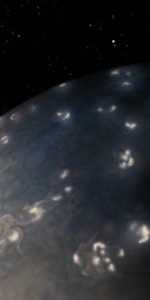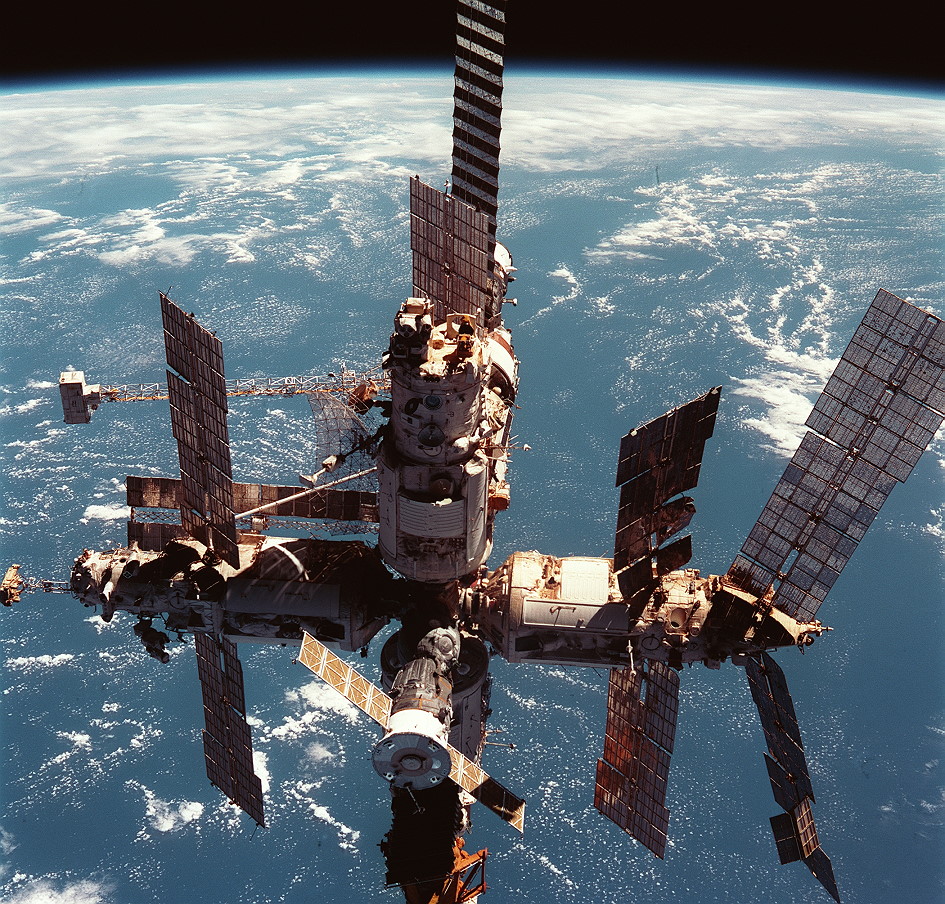
Twenty years ago, this week, shuttle Discovery pulled away from Russia’s Mir space station for the final time, closing out a group of impressive rendezvous and docking missions which had cemented a new partnership between two old rivals and had laid much of the groundwork for the construction and operations of the International Space Station (ISS). On 8 June 1998, as the STS-91 and Mir crews bade one another farewell, the station commander, Talgat Musabayev, pulled out a surprise gift for shuttle commander Charlie Precourt. It was a 24-inch (60 cm) wrench.
“Charlie, take this wrench,” Musabayev grinned. “It’s sort of a relay stick from the Old Lady, Mir, to the International Space Station.”
“We’re going to need this,” Precourt replied, “for all the work that we have ahead of us.”
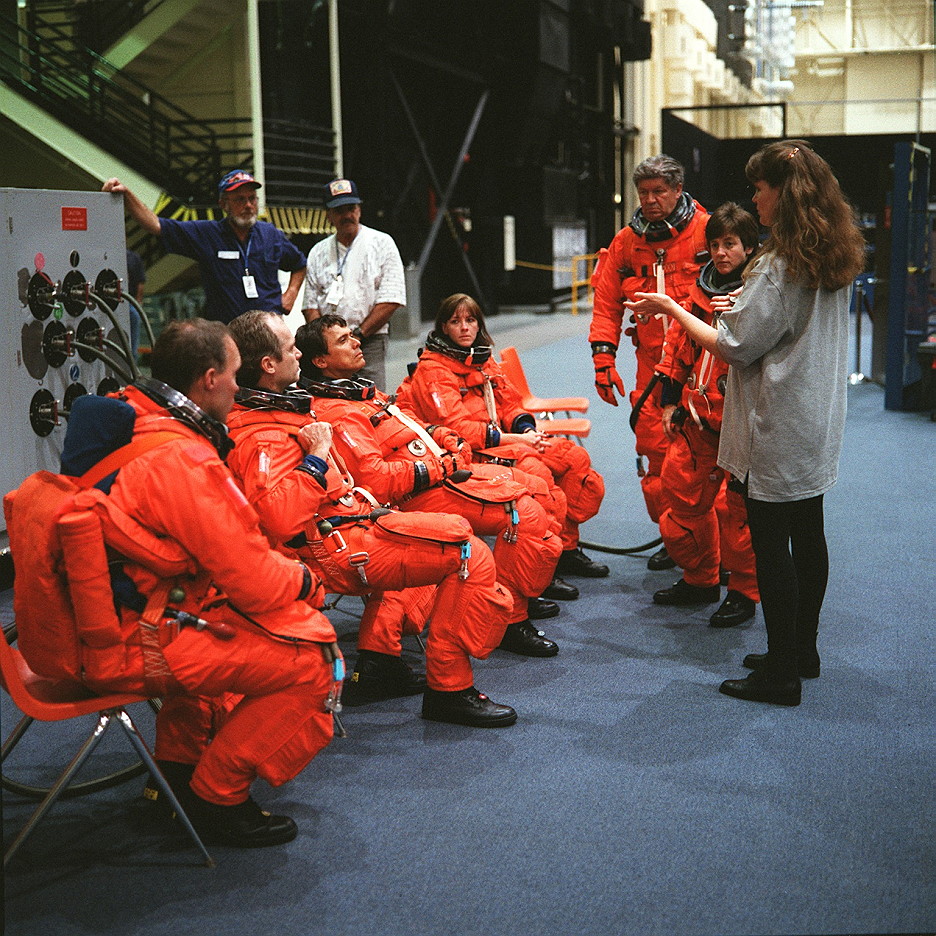
STS-91, the ninth and final shuttle-Mir docking mission, was the end of a truly remarkable era which had seen NASA’s reusable fleet of orbiters transition from their post-Challenger role of launching and retrieving satellites and performing scientific research into a vehicle which could visit and build space stations. In December 1993, up to ten shuttle-Mir flights were agreed between the United States and Russia, leading to a cosmonaut voyaging aboard the shuttle in February 1994 and an astronaut spending four months aboard the station in the spring of 1995. This was followed by three years of shuttle-Mir docking flights, beginning with STS-71 in June 1995, which delivered equipment and supplies and exchanged long-duration crew members aboard the station. STS-91, commanded by Charlie Precourt, would transport 1,100 pounds (500 kg) of water and 4,630 pounds (2,100 kg) of cargo, experiments and necessities to the aging orbital outpost, as well as bringing home U.S. astronaut Andy Thomas after almost five months in space.
The crew was an unusual one. Named in two parts between October 1997 and January 1998, its core consisted of Precourt—the only American to fly as many as three times to Mir—together with pilot Dom Gorie and mission specialists Franklin Chang-Diaz, Wendy Lawrence and future Glenn Research Center (GRC) director Janet Kavandi. Lawrence had originally been intended to fly a long-duration mission to Mir, but was thwarted on two occasions—firstly, by being too short to safety fit within the confines of Russia’s Soyuz spacecraft, earning the unenviable nickname of “Too Short”, and secondly, by being unable to fit the Orlan (“Eagle”) spacewalking suit—before eventually flying on STS-86, the seventh shuttle-Mir mission, in the fall of 1997. By the time she finally flew, Lawrence had been notified by Chief Astronaut Bob Cabana that she would also fly STS-91, a few months later. “He felt pretty adamant about making sure that my participation in the program would be rewarded,” Lawrence explained in a NASA oral history. “What most people didn’t know at that time, what I knew, was that I would fly on 86 and I would fly on 91, so that’s why a lot of reporters just couldn’t understand why I wasn’t devastated! I knew that I was getting two flights out of it.”
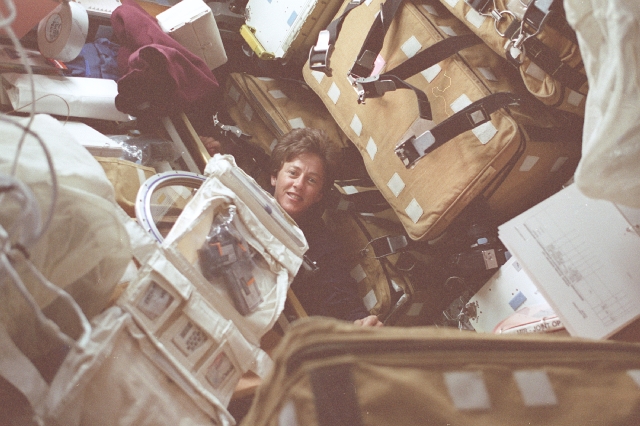
Within five hours of landing on STS-86 on 6 October 1997, Lawrence received a telephone call from Precourt, inviting her to the first STS-91 crew meeting. Two weeks later, on 23 October 1997, the crew roster was officially announced. And in January 1998, veteran cosmonaut Valeri Ryumin—then serving as program manager of the Russian side of the shuttle-Mir program—was announced to fly. Aged 58, he would be the oldest Russian ever to launch into space at that time, an achievement which would remain unbroken until 59-year-old Pavel Vinogradov flew to the ISS in 2013. Despite his spaceflight experience, Ryumin’s last mission had been in 1980, almost two decades earlier, which required him to lose 55 pounds (25 kg) in weight, pass through various medical boards and obtain direct approval from his superiors to fly again. He would serve as an observer to assess the state of Mir, which had endured a major fire and partial depressurization in 1997.
STS-91 would also offer a nod to the forthcoming ISS era by flying with the first Super-Lightweight Tank (SLWT), an upgrade on the shuttle’s External Tank (ET), whose weight had been trimmed by about 7,500 pounds (3,400 kg). At 6:06 p.m. EDT on 2 June 1998, Discovery sprang from Earth on the 24th mission of her career, delivering the six-strong crew smoothly into orbit. For Janet Kavandi, the ignition of the twin Solid Rocket Boosters (SRBs) which brought tears to her eyes. “I was actually crying on the way up,” she recalled later, “not because I was scared, but because it was just a flood of emotion as I felt all the power and everything thrusting us into space.”
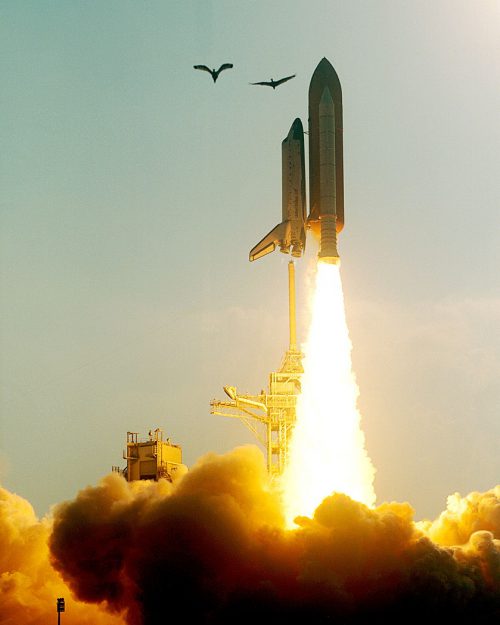
Two days later, Precourt and Gorie guided their ship to a smooth docking with Mir. And over the next five days, they worked with the incumbent station crew of Russian cosmonauts Talgat Musabayev and Nikolai Budarin and NASA’ Andy Thomas. Supplies were transferred from a Spacehab pressurized cargo module in the shuttle’s payload bay and work was also conducted with a precursor version of the Alpha Magnetic Spectrometer (AMS), which today sits aboard the ISS as a major particle physics instrument.
To his surprise, Precourt found Mir in better condition than on his most recent flight, a year earlier. Although one of its modules had been sealed off, following a collision with a Progress supply ship and depressurization, he noticed that the air was cleaner and the temperature was better. “The walls of the surfaces of the structures everywhere were dry,” he said later. “There had been lots of humidity on my previous two visits that was evident everywhere.” For Ryumin, however, it offered a quite different perspective. He was shocked by the amount of clutter aboard Mir—which he felt made acclimatizing to life in space more difficult for the station’s crews—and on one occasion he even found rubbish behind a wall panel. Upon asking Russian flight controllers for permission to remove it, his request was turned down, on account of the area carrying critical electrical cables, which could not be moved. Even Mir’s commander, Musabayev, frequently deferred to Ryumin during space-to-ground conferences. On one occasion, where camera brackets did not fit properly, an irritated Ryumin told the ground that this problem needed to be noted in the mission report in red capital letters.
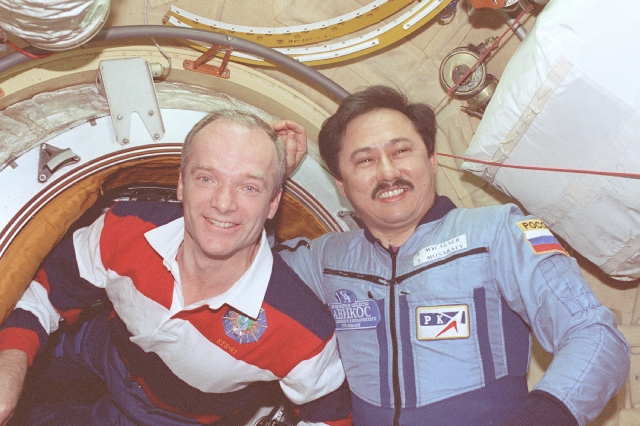
In these final days of the shuttle-Mir program, there was time for celebration. On 5 June, Ryumin passed a cumulative year in space, counting his three previous missions aboard the Salyut 6 space station, almost two decades earlier. The astronauts and cosmonauts observed the milestone with a joint meal and Musabayev pulled out his guitar and strummed a few Beatles numbers, a handful of traditional Russian and Kazakh folk-songs and even tunes by the Soviet singer-songwriter Vladimir Vysotsky.
On 8 June, Thomas transferred to the shuttle and Discovery undocked shortly after midday EDT. With Gorie flying the shuttle, Precourt was able to offer a few remarks to Canadian astronaut Marc Garneau, sitting at the Capcom’s console in the Mission Control Center (MCC) at the Johnson Space Center (JSC) in Houston, Texas.
“It sure is a pretty view of the station, from here, with the Sun coming,” Precourt said. “We’re just sitting here in position and they’re tracking the Sun and it’s just glowing. It’s really something!”
“Enjoy the view,” replied Garneau, “because you’re probably the last crew to have a good look at Mir.”
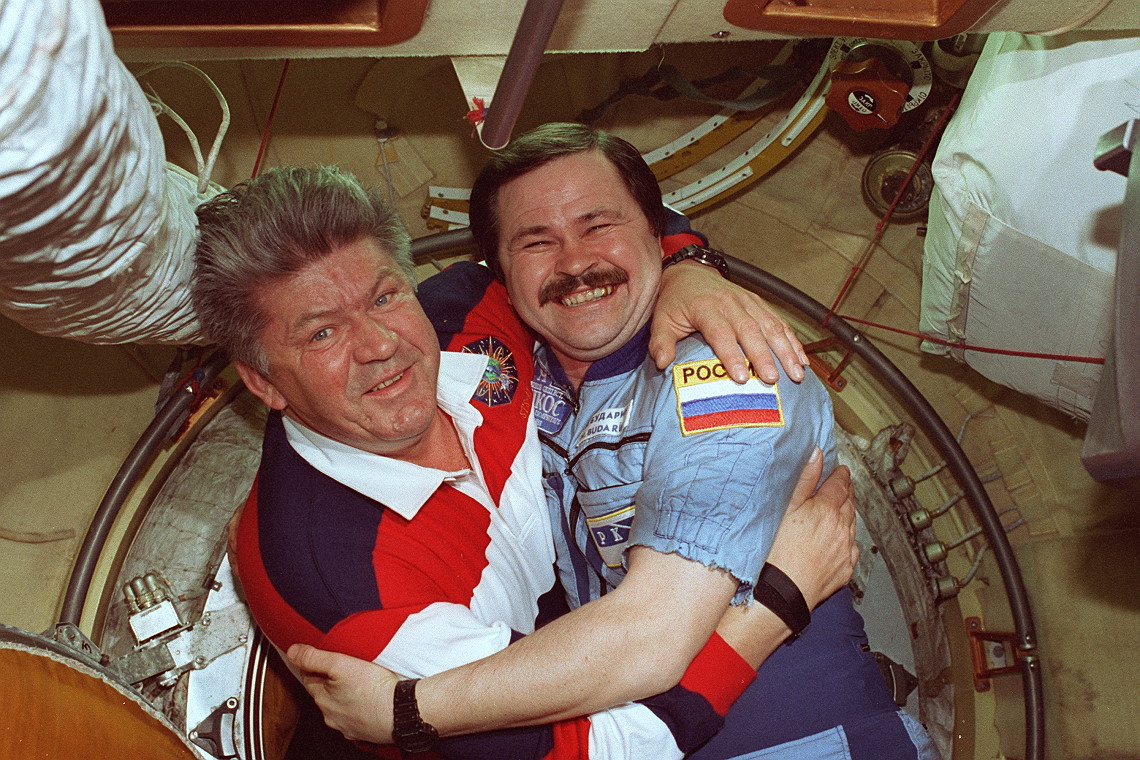
There had been some hope, at least on the Russian side, that a tenth shuttle-Mir mission might have been flown. “To tell you the truth, I feel very sorry that…we will end our program,” Ryumin said in early 1998. “I don’t want to leave it at the ninth, so maybe we need to think about how we can extend this phase to include another, tenth, flight.” Such hopes were inevitably inspired by Russia’s unwillingness to rid itself of Mir, which would become a virtual inevitability without the lifeline provided by the shuttle, and which many Russians saw as a shining beacon of national pride. However, NASA Administrator Dan Goldin had been adamant that the program would end with STS-91 and emphasis would shift to the construction of the ISS, which eventually got underway in late 1998.
Discovery’s landing thus brought down the curtain on a remarkable era and signaled the beginning of the end for Mir. The old station, whose first components had risen to orbit in February 1986—at the height of the Cold War—endured for another three years, seeing a handful of long-duration crews, the last of which departed in June 2000. Efforts to “commercialize” Mir, as a means of prolonging its life, ultimately came to nought and the station was deorbited in March 2001. Yet many astronauts, cosmonauts, engineers and managers unanimously agreed that the challenges of the shuttle-Mir program had strengthened the two nations’ partnership for the ISS. In the words of Wendy Lawrence, the Russians were no longer enemies. Nor were they just comrades. In fact, they had become friends.
FOLLOW AmericaSpace on Facebook!
.




